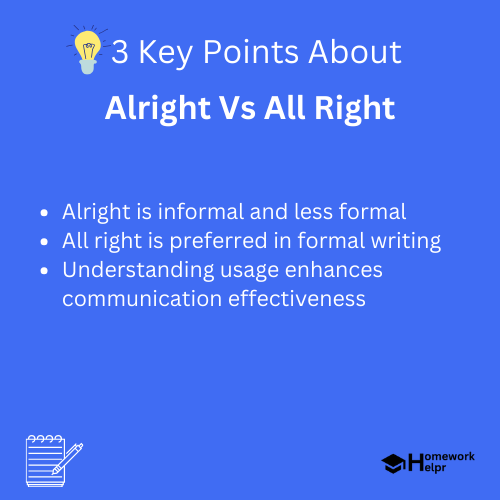📝 Summary
Understanding the difference between alright and all right is important for effective communication. While alright is a less formal variant used in informal settings like texts and social media, all right is the standard form preferred in formal writing. Both terms can indicate that something is acceptable, but their usage differs based on context. Knowledge of these nuances can enhance your language skills and ensure clarity in conversations, reflecting your command over English. Remember to choose alright for casual and all right for formal situations.
Understanding the Difference: Alright vs. All Right
The English language is rich and diverse, filled with words that often cause confusion. One such pair of terms is ‚Äúalright” and ‚Äúall right.” While they may appear similar, understanding their nuances is essential for effective communication. This article will delve into the meanings, usage, and examples of both terms to help you clarify any confusion.
What Does ‚ÄúAlright” Mean?
The term ‚Äúalright” is considered a less formal variant of ‚Äúall right.” It is usually used in informal writing and conversations, such as text messages, social media, or casual emails. The word can convey approval or indicate that something is satisfactory.
For instance, if a friend asks how your day was, you might respond with ‚ÄúIt was alright,” suggesting that your day was neither great nor terrible but acceptable. This term has gained popularity over the years, especially among younger generations.

Definition
Informal: A style of communication that is casual and not adhering strictly to formal language rules.
Examples
Example 1: ‚ÄúThe movie was alright, but I expected more.”
Examples
Example 2: ‚ÄúAre you feeling alright today?”
Exploring the Meaning of ‚ÄúAll Right”
On the other hand, ‚Äúall right” is the standard form and is generally preferred in formal writing. It is often used to convey that something is whole or complete, and it can also signify that a situation is acceptable or satisfactory.
In formal contexts, using ‚Äúall right” reflects a greater command of the language and may enhance your credibility as a writer or speaker. For example, in an academic paper, you would state, ‚ÄúThe results of the experiment were all right, indicating that the hypothesis was partially supported.”
Definition
Credibility: The quality of being trusted and believed in, often based on expertise or reputation.
Examples
Example 1: ‚ÄúEverything is all right now after the changes were made.”
Examples
Example 2: ‚ÄúHis grades this semester were all right, but he can improve.”
Comparing Usage: Alright vs. All Right
While both terms can sometimes be used interchangeably, it‚’ important to understand the context in which they are used. Here‚’ a summary of when to use each:
- Use ‚Äúalright”: In informal settings, such as casual conversations, texts, or social media.
- Use ‚Äúall right”: In formal or academic writing where professionalism is required.
Common Mistakes and Misconceptions
Many people mistakenly believe that ‚Äúalright” is an incorrect form of ‚Äúall right.” While ‚Äúalright” is widely accepted in everyday conversation and increasingly in written form, traditionalists often argue that it should not be used in formal writing.
Another common misconception is using these terms to imply different meanings. In reality, both can indicate that something is adequate or acceptable, but the formality of the situation will dictate which one to choose.
❓Did You Know?
Did you know? ‚ÄúAlright” has been used in literature as far back as the 19th century, so it’s been around for a long time!
Examples in Everyday Language
Now that we understand the definitions and usage of ‚Äúalright” and ‚Äúall right,” let‚’ look at some examples in real-life scenarios to solidify your understanding.
- In a conversation: ‚ÄúI‚Äôm feeling alright, but I could use a little more sleep.”
- In an academic report: ‚ÄúThe team‚’ performance was all right this season, with a few standout players.”
- In a social media post: ‚ÄúEverything is alright with the project so far!”
Why the Distinction Matters
Understanding the distinction between ‚Äúalright” and ‚Äúall right” impacts your ability to communicate more effectively. Using the correct term in the proper context not only enhances your writing style but also conveys your knowledge and expertise of language. Additionally, being aware of this difference can help you avoid misinterpretations in your conversations.
Definition
Misinterpretation: The act of misunderstanding or incorrectly interpreting something.
Conclusion
In summary, while ‚Äúalright” and ‚Äúall right” may seem similar, recognizing their differences is crucial for both spoken and written communication. As you navigate through your English studies, keep these distinctions in mind to enhance your language skills and ensure clarity in your conversations. Whether you choose to use ‚Äúalright” in informal settings or ‚Äúall right” in formal ones, being mindful of your choices will reflect your understanding of the language.
Related Questions on Alright Vs All Right
What is the difference between alright and all right?
Answer: Alright is informal; all right is formal.
When should I use alright?
Answer: Use alright in casual conversations and text messages.
Is alright considered incorrect in formal writing?
Answer: Traditionalists argue it‚’ incorrect; prefer all right.
Can both terms mean the same thing?
Answer: Yes, both indicate something is acceptable or satisfactory.
